Oxides and hydroxides: Brooke
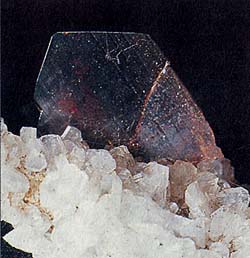 Diagnostic Card.
Diagnostic Card.
Ti O 2 (titanium oxide)
Crystal system orthorhombic
Hardness of 5.5-6
The proportion of 3.9-4.2
Cleavage bad differs
The break in the wrong
Color from brown to black
Color powder yellow-brown, yellow
Shine from the metal to the diamond

Always there is a beautiful shiny crystal clear tabular shape, sometimes strongly isshtrihovannyh. Color is close to the color of anatase and can vary from light brown to black train.
Chemical composition - content (%): TiO2 - 94,09- 98,77; Fe2O3 - 4.5; Nb2O5 and Ta2O5 - to 9.6. Painting is often uneven, in transmitted light are clearly distinguished by the darker color characteristic of pyramids of growth (001) (122) (021) and other yellowish, evenly distributed color of crystals brookite from the Polar Urals due to ferric compounds, greenish color of growth pyramids. - ferrous iron compounds; According to Arnold, the darker coloring of growth pyramids associated with entering into the lattice of niobium.
Transparency - from almost transparent to translucent and well neprosvechivayuschego (train-ferrous brookite). Fracture - IPT uneven conchoidal unclear. Fragile. Crystal system - Monoclinic; prismatic form of symmetry. Cleavage - at (110) It is not clear yet less clear on (001). Assemblies - Individual crystals. Do not melt. With a salt of phosphoric oxidized. Sq. It gave a colorless or brownish (brookite dark, rich in iron) glass, in the Restore. Sq. with a grain of tin - purple glass. Behavior in acid - insoluble.
Diagnostic features.
Like the anatase crystal habit does not allow brookite confused with other minerals.
Origin.
Brook - typical mineral in alpine schists. There it is often present together with anatase, but in contrast, the more rare.
Deposits and application.
Beautiful crystals found in Gridzhoni (Switzerland), in the French Alps and Austria. Beyond the Alps, beautiful crystals received from the Urals and mostly from Magnet Cove (Arkansas, United States). These black crystals are tabular, and is short-(variety arkanzit). Some deposits contain enough of this mineral to ensure its production as an ore for titanium.
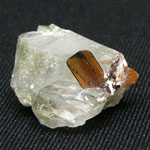
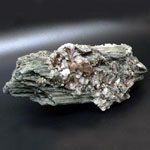
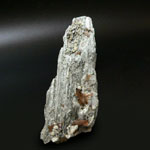
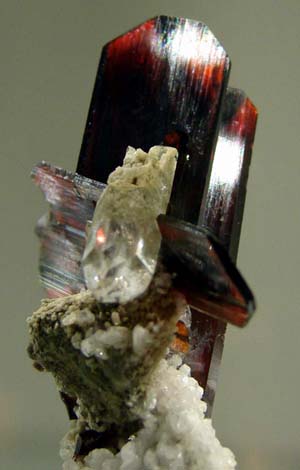
Brooke (crystal 3 cm). Pakistan. Munich-show-2007.
Toxicity of titanium. Nanoparticles - titanium dioxide (brookite), which can be found on the cosmetics and sunscreens to dyes and vitamins - cause systemic genetic changes. Nanoparticles of titanium dioxide cause ruptures single- and double-stranded DNA and chromosome damage (DNA and RNA unwinding, "youth hormone"), which increases the risk of developing cancer (lymph nodes). They are the cause of the inflammation and the development of the living tissues of the body (oxygen blocking). Nanoparticles of titanium dioxide (brookite) have a mechanism of toxicity, causing physical and chemical reactions in the body that could result in even "spontaneous development of cancer."
Production of nanoparticles of TiO2 (eelmentov main components) - it is an industry that produces them in quantities of millions of tons. Furthermore paints, cosmetics, sunscreens and vitamins, the nanoparticles can be found in food dye, toothpaste, and hundreds of other personal care products. Once in the body, TiO2 nanoparticles accumulate in various organs in the body because there is no mechanism for their removal. Since the nanoparticles are very small, they can move throughout the body, passing through the cells and interfering with intracellular mechanisms.
Previously, the titanium dioxide particles is not considered toxic. However, they interact with surfaces that are in close proximity, - causing damage to the genetic apparatus. They travel through the body causing oxidative stress (hypoxia), which leads to cell death (rob cells of oxygen, asphyxia, lack of oxygen). The titanium compounds - pyrophoric substances (active catalysts and combustion oksileniya). It is advisable to limit the use of titanium dioxide inside (intestine, mucous membranes, gastrointestinal tract) with a biologically active food additives (BUDS), food dyes, etc.
In medicine, TiO2 is used externally - in dermatological practice for the treatment of light-sensitive cheilitis, herpes, acne, inflammation of the lips and mouth, while removing facial hemangiomas by tattoos, is a member of various medicines and cosmetic products. According to a comprehensive study conducted by researchers at the University of California, Los Angeles (UCLA), led by Professor of pathology, radiation oncology and environmental security researcher Jonsson Cancer Center Shistla Robert (Robert Schiestl). Adding TiO2 nanoparticles in drinking water (inside outwardly, in the complex).
ADR 4.1

Flammable solids, self-reactive substances and solid desensitized explosives
Risk of fire. Flammable or combustible materials can be ignited by sparks or flames. May contain self-reactive substances that are liable to exothermic decomposition in the case of heating, contact with other substances (such as acids, heavy-metal compounds or amines), friction or shock.
This may result in the evolution of harmful and flammable gases or vapors or self-ignition. Containers may explode when heated (ultra-hazardous - practically do not burn).
Risk of explosion of desensitized explosives after loss of desensitizer
Seven vertical red stripes on a white background, of equal, the number of ADR, the black flame
ADR 4.2

Substances capable of autoignition
Risk of fire as a result of self-ignition if packages are damaged or there is the source of the content.
May react vigorously with water
White upper half of the rhombus, red - the lower, equal size, number of ADR, the black flame
ADR 8

Corrosive (corrosive) substances
Risk of burns by corrosion. May react violently with each other (component) with water and other substances. The substance that spilled / scattered, can release corrosive steam.
Constitutes a danger to the aquatic environment or the sewage system
White upper half of the lozenge, black - bottom, of equal, the number of ADR, tubes, hand
| Name of especially dangerous during transportation of cargo | room
UN |
Class
ADR |
| TITAN - porous beads or titanium - Porous Powders | 2878 | 4.1 |
| TITAN - POWDER WETTED with a mass of water of not less than 25% | 1352 | 4.1 |
| TITAN - POWDER DRY | 2546 | 4.2 |
| Titan granulated TITAN - porous beads or titanium - Porous Powders | 2878 | 4.1 |
| Titanium tetrachloride, titanium tetrachloride | 1838 | 8 |
| titanium hydride | 1871 | 4.1 |
| titanium disulfide | 3174 | 4.2 |
| titanium tetrachloride | 1838 | 8 |
| Titanium trichloride or titanium trichloride, pyrophoric pyrophoric MIXTURE | 2441 | 4.2 |
| Titanium trichloride MIXTURE | 2869 | 8 |
- Gatchell - "New Almadén snag" - arsenide and antimony sulfide (modern sulphosalts)
- Antimony - toxic metal (semi-metal) are widely used in industry, medicine and engineering
- Zirconium - a rare and non- metal and dangerous jewel in the oxide and salts
- Gold - yellow dangerous and toxic metal -date and accurate digital cable technology
- Sulphur - a golden-yellow toxic substance and a sign of volcanic activity
- Cadmium - a toxic uncirculated unknown wide range of people silvery metal
- Lead - a poisonous gray simulator silver metal and toxic metal snag
- Arsenic - poison classic medieval and modern poisoners and medicine in medicine
Toxic and hazardous radioactive rocks and minerals
** - Poisonous stones and minerals (obligatory check in chemical laboratory + clear indication of toxicity)
** - Radioactive rocks and minerals (obligatory check on a regular dosimeter + ban on the open sale of radioactivity in the event of more than 24 mR / hour + additional measures to protect the population)
Catalog minerals and gems in groups of the world
** - Poisonous stones and minerals
** - Radioactive rocks and minerals


Comments
Commenting, keep in mind that the content and the tone of your messages can hurt the feelings of real people, show respect and tolerance to his interlocutors, even if you do not share their opinion, your behavior in terms of freedom of speech and anonymity offered by the Internet, is changing not only virtual, but real world. All comments are hidden from the index, spam control.